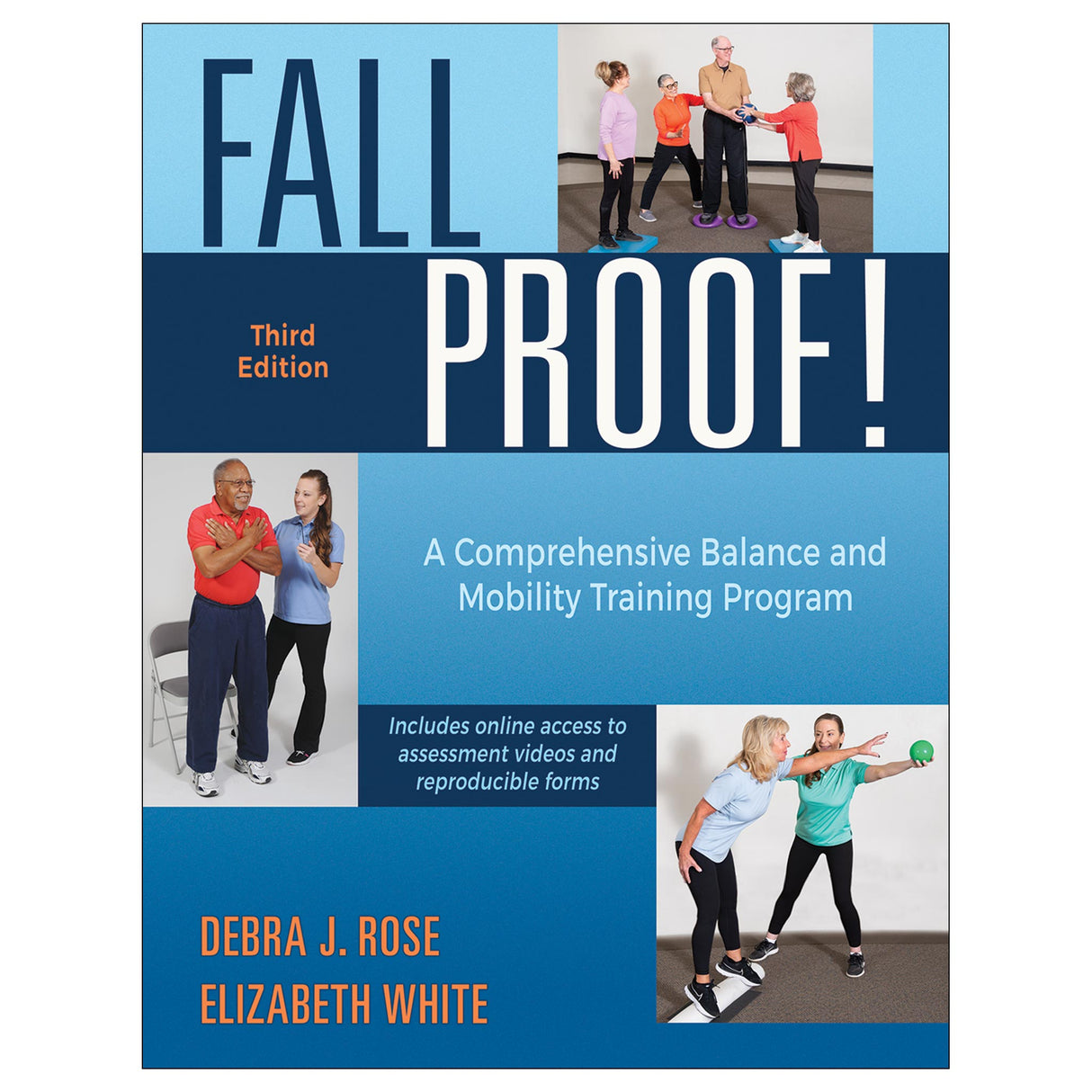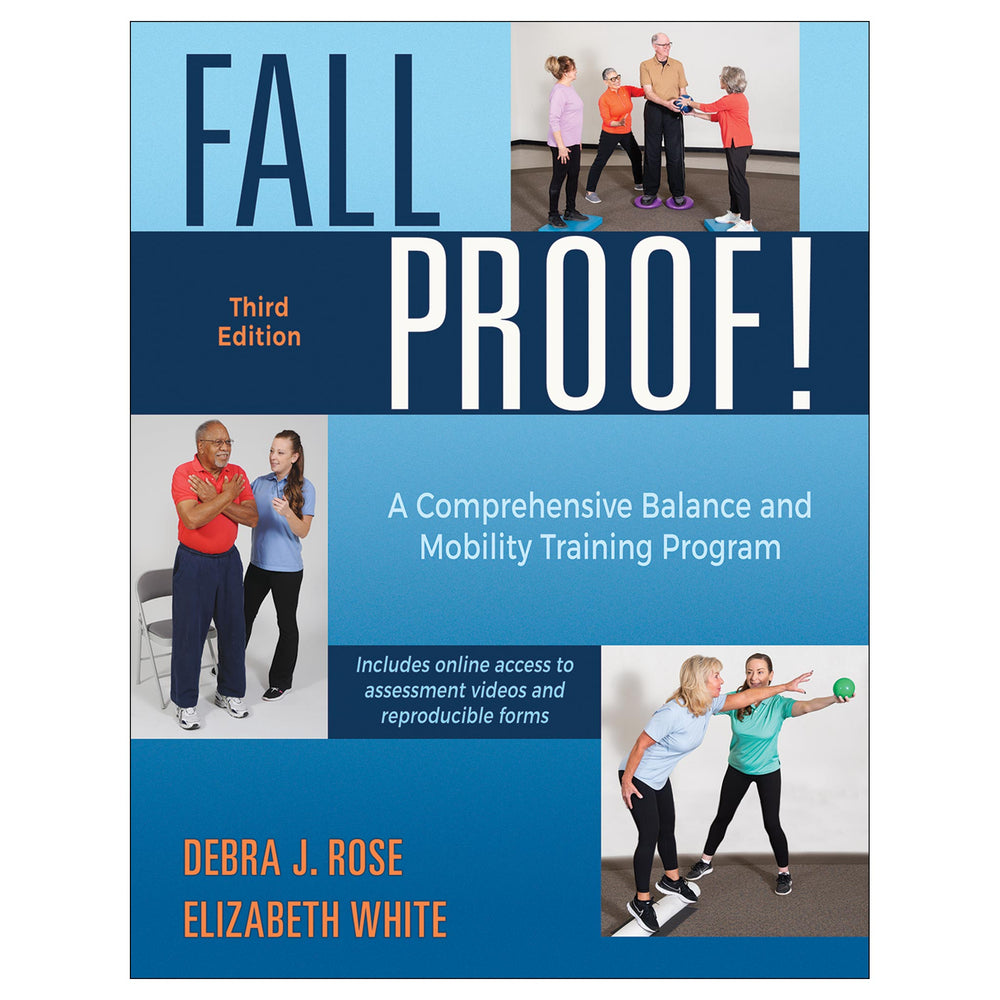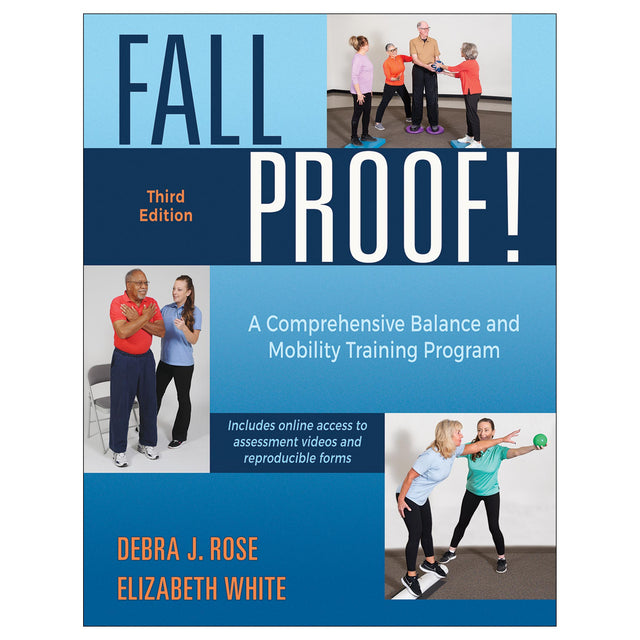FallProof! 3rd Edition Ebook With HKPropel Access
A Comprehensive Balance and Mobility Training Program
Author: Debra J. Rose, Elizabeth White
$75.95 CAD

Written by the foremost experts in balance disorders, Debra Rose and Elizabeth White, this third edition includes key updates to the guidelines, tests, and programming that made the previous editions so popular and made the FallProof program so widely recognized throughout the industry.
Thoroughly updated with the latest research and revised assessments, including the Expanded Fullerton Advanced Balance (E-FAB) scale and the Walking While Talking Test, this resource is indispensable for health professionals working with the older adult population.
The third edition features new activities for improving seated balance and center-of-gravity control as well as for encouraging a flexible and adaptable gait to reduce the risk of falling. Case studies, expert insights, and practical analysis prepare practitioners to anticipate, understand, and manage the age-related changes their clients experience. Professionals can help clients address the functional limitations that often result in falls with a variety of balance, strength, endurance, and flexibility exercises:
- 17 upper-body exercises, 4 of which are new
- 4 new abdominal exercises
- 18 lower-body and foot and toe exercises
- 5 new compound floor exercises
- 30 flexibility exercises and stretches, 7 of which are new
Earn continuing education credits/units! A continuing education exam that uses this book is also available. It may be purchased separately or as part of a package that includes both the book and exam.
Note: A code for accessing HKPropel is included with this ebook.
Audience
Professionals working with older adult populations in retirement communities, physical activity programs, rehabilitation and therapy programs, and long-term care facilities.Part I. The Theory Behind the Program
Chapter 1. Understanding Balance and Mobility
What Is Balance?
Terminology
Postural Control Strategies for Controlling Balance
Systems Contributing to Balance and Mobility
Age-Associated Changes in the Systems Contributing to Balance and Mobility
Case Studies
Summary
Test Your Understanding
Practical Problems
Chapter 2. Why Do Many Older Adults Fall?
Multiple Factors Cause Falls
Effects of Common Medical Conditions
Effect of Medications on Balance and Mobility
Fear of Falling
Are the Risks the Same for All Older Adults?
Practical Implications for Program Planning
Summary
Test Your Understanding
Practical Problems
Part II. The FallProof Program for Improving Balance and Mobility
Chapter 3. Screening and Assessment
Systems Framework for Postural Control
Health and Physical Activity Patterns
Assessing Functional Ability
Assessing Fall Risk
Assessing the Multiple Dimensions of Balance and Gait
Summary
Test Your Understanding
Practical Problems
Chapter 4. Center-of-Gravity Control Training
Seated Balance Activities
Standing Balance Activities
Floor-to-Standing Transfers
Summary
Test Your Understanding
Practical Problems
Chapter 5. Multisensory Training
Forcing the Use of the Somatosensory System to Control Balance
Forcing the Use of the Visual System to Control Balance
Forcing the Use of the Vestibular System to Control Balance
Exercises Coordinating Eye and Head Movements
Summary
Test Your Understanding
Practical Problems
Chapter 6. Postural Strategy Training
Practice Requirements
Progressive Exercise Activities
Summary
Test Your Understanding
Practical Problems
Chapter 7. Gait Pattern Enhancement and Variation Training
Overview of the Gait Cycle
Mechanisms Controlling Gait
Age-Associated Changes in Gait
Effect of Pathology on the Gait Pattern
Gait Pattern Enhancement and Variation Training
Culminating Activities
Summary
Test Your Understanding
Practical Problems
Chapter 8. Strength and Endurance Training
Selected Upper-Body Strength Exercises
Selected Abdominal Strength Exercises
Selected Lower-Body Strength Exercises
Selected Compound Floor Exercises
Selected Exercises for the Foot and Toes
Summary
Test Your Understanding
Practical Problems
Chapter 9. Flexibility Training
Selected Neck and Upper-Body Flexibility Exercises
Selected Lower-Body Flexibility Exercises
Selected Floor-Based Flexibility Exercises
Summary
Test Your Understanding
Practical Problems
Part III. Implementing the FallProof Program
Chapter 10. Setting the Stage for Learning
Understanding the Stages of Learning
Understanding Different Learning Styles
Introducing the Skill Being Learned
Identifying and Correcting Errors in Performance
Summary
Test Your Understanding
Practical Problems
Chapter 11. Program Planning and Class Management Techniques
Following the Initial Assessment
Setting Individual Program Goals
Before Each Class Session
During Each Class Session
Between Class Sessions
After Each Follow-Up Assessment
Communicating With Class Participants
Summary
Test Your Understanding
Practical Problems
Appendix A. Balance Kit Inventory
Appendix B. Answer Key for Test Your Understanding Questions






